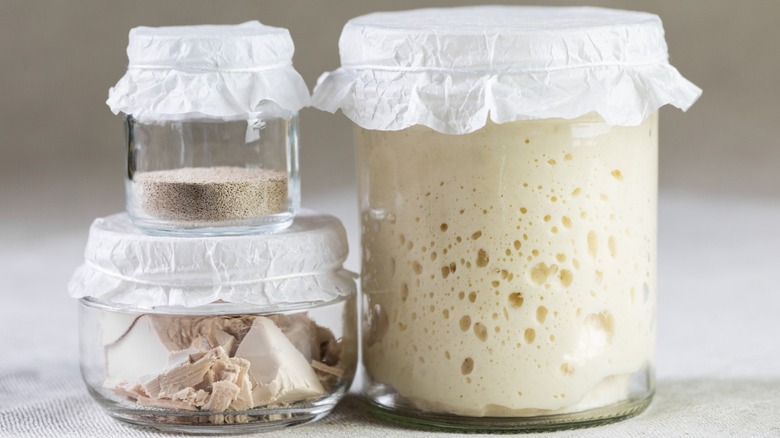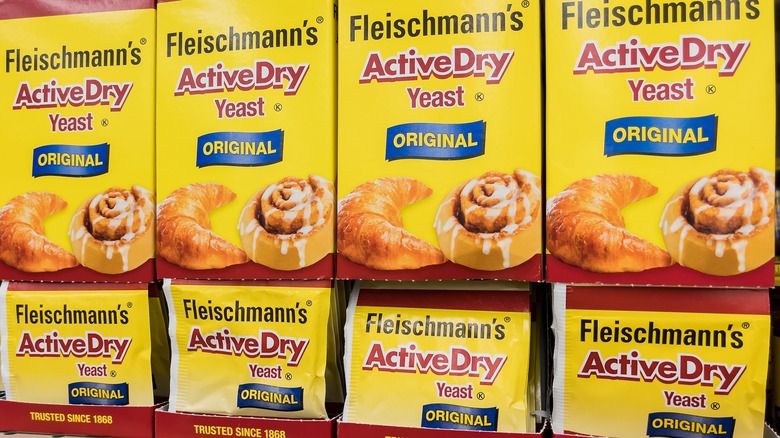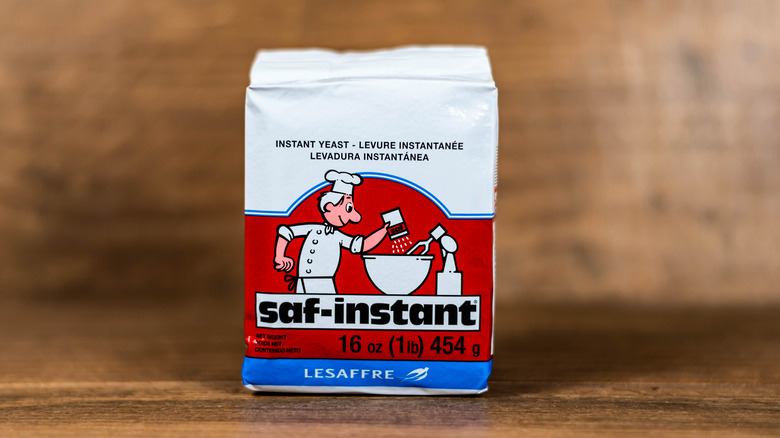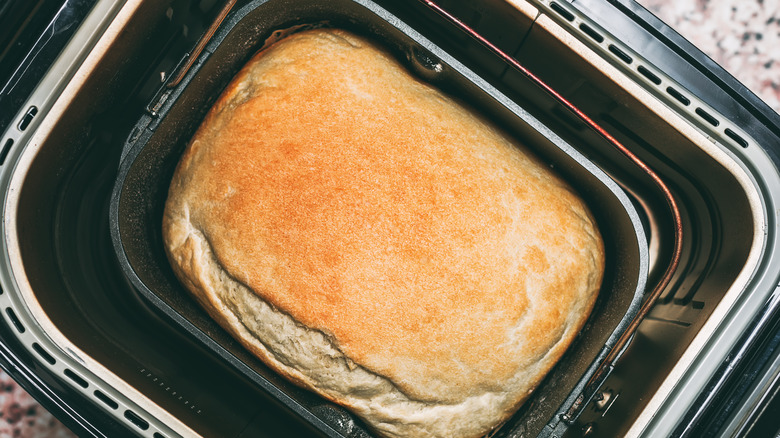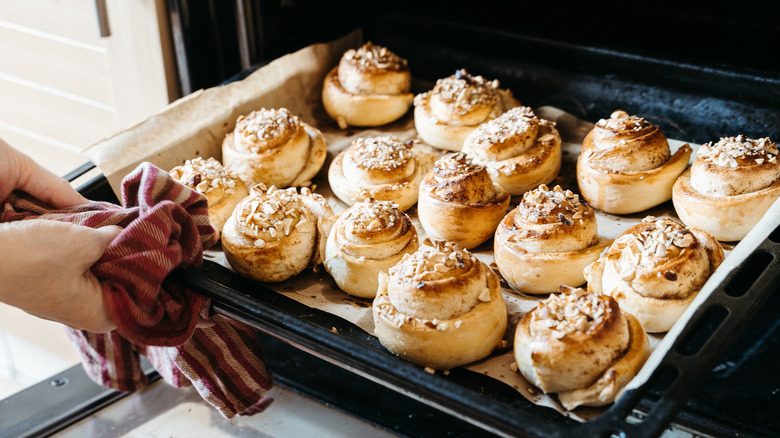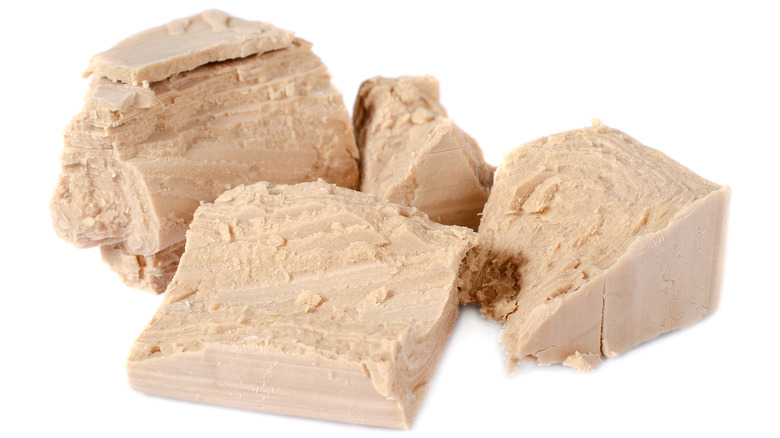5 Types Of Yeast And How To Pick The Right One When Baking
Anyone who's ever watched their own loaf of bread rise in a hot oven knows the excitement that baking with yeast arouses. Getting your doughy hands on a living, breathing thing is a powerful moment in the life of your kitchen; it channels an almost elemental sort of energy. Yeast's mysterious force is often misunderstood. Hundreds of years ago, keeping and preserving yeast was a tricky and somewhat unpredictable operation, but these days we can purchase yeast easily at any supermarket (per Explore Yeast).
But great power is sometimes followed by great confusion. Now that we've found a way to harness the potential of yeast in granulated, packaged form, how do we figure out which yeast is the right one to use? If you're puzzling over this question, there are ways to simplify and clarify the process.
It's worth noting that part of the confusion results from the fact that there's no clear regulation around the terminology that brands use, so words like "rapid, " "instant" and "quick" can mean different things to different people, easily leading to misunderstanding. In addition, there is considerable difference of opinion — even among very experienced bakers.
Active Dry Yeast
Serious Eats explains that there are two main types of yeast. Active dry yeast ("traditional" yeast) is the most readily available form, and it generally needs to be activated before you use it. It typically comes in small packets stamped with an expiration date, sometimes in the refrigerated section of a store since it keeps best in cooler temperatures (per Market Basket). Most bakers (including Serious Eats and Seasons and Suppers) agree that you should proof it to confirm that the yeast is truly active (i.e. that it works) by adding warm water, usually with a pinch of sugar.
In theory, if the yeast is active, the proofing should be an unnecessary extra step, as King Arthur Flour's expert PJ Hamel contends, insisting that you can go ahead and add your yeast directly to whatever you're baking. But there are two potential problems with the direct-add method that Hamel advocates: active dry yeast is not very stable and often becomes inactive, and the granules may not dissolve completely without proofing. (If you really want to make sure your yeast granules will dissolve completely into your dough, you can always make a baking "sponge" first, per Baker Betty). But if you are sure the yeast is active, and you're not worried about gritty granules, you can go ahead and skip the proof, eliminating an extra step.
Instant Yeast
The second major type of yeast is instant yeast, which follows a different manufacturing process, resulting in a much more stable yeast than active-dry. The "instant" part of instant yeast doesn't refer to the speed with which the yeast does its stuff — it has to do with the fact that the yeast is "instantly" ready to be added to the dough. Instant yeast does not need to be proofed and its smaller granules also make it easier to incorporate into your dough. The other difference is the variety of yeast used in manufacturing, as Susan Reid noted to Epicurious, "Instant is a slightly different strain, so it produces a bit of a different flavor." It's the go-to yeast for the bakers over at King Arthur Flour as well as most professional bakers since it's more reliable than the traditional variety. It keeps very well refrigerated or even in the freezer, reducing its cost considerably.
While instant yeast doesn't need proofing, If you are substituting instant yeast for active dry, and choose to proof for consistency, instant yeast can tolerate hotter water — 130 F compared to the 110 F that is usually the outside limit for active dry yeast, as Seasons and Suppers and Serious Eats both point out. Both active dry yeast and instant are intended for traditional, double-rise baking methods.
Bread Machine Yeast
Bread Machine or Pizza Yeast: As the name suggests, bread machine yeast is intended to be added directly to the ingredients in a bread-making machine. Aside from the name, bread-machine yeast is pretty much the same as instant yeast, and — like instant yeast — keeps very well. They Differ suggests that the rising time is considerably shorter for bread machine yeast, and recommends using it for bread-machine bakers. Seasons and Suppers notes its strategic use for pizza as well.
Not everyone finds there's much of a difference, however: Bread Machine Diva, in her attempts to de-mystify the uses of yeasts for bread machines, points out that bread machine yeast is simply a type of instant yeast. While Bread Machine Diva's experiments did not detect a significant difference between bread machine yeast and other yeasts, she points out that you should avoid proofing your yeast if you're adding it to a bread machine. Bottom line: if you are using a bread machine regularly, it's worth trying this form of yeast for its rising time. But using instant yeast or even active-dry shouldn't be a problem.
RapidRise / Quick-Rise Instant Yeast
RapidRise (made by Fleischmann's) and Quick-Rise (produced by Red Star) yeasts feature both the smaller granules of instant yeast and a shorter activation time, meaning that baked goods only require one rise. This is wonderful for specialty items (like cinnamon buns or dinner rolls), but this is generally a limited-use yeast, since (per King Arthur Flour) most breads acquire their flavor from the traditional two-step rise.
While it can be used in a bread machine, hardcore bakers (like King Arthur) still recommend instant yeast for richness and depth of flavor, even in a machine. But if you're fine with a bit of loss in the crumb and flavor department for a clear gain in speed, this is a yeast to try: While the second rise is important to the taste of fresh bread, it's not as critical as the first. Some people have found the difference between once- and twice-risen bread to be less noticeable than they expected, so if you're trying to bake under pressure for hungry family or friends this could be your new yeast friend!
Fresh Yeast
Fresh yeast (cake or compressed yeast) is a harder-to-find, more expensive, highly perishable form of yeast that comes in crumbly round bricks. Some bakers, like Adam Leonti (via Epicurious), consider that it imparts better flavor — especially to fresh bread — and swear by it, while others (like The Kitchn) are decidedly underwhelmed. If you're an avid baker, it may be hard to resist. If you decide to give it a go, look for it in the refrigerated section of the store — keep in mind that you will need to use it up quickly, so check the expiration date — if it's too dark or too hard it's past its prime.
If you're trying to keep your yeasts straight, just remember: Instant yeast is the most reliable and best standard yeast for most people and uses, but you can substitute active-dry if you don't mind the proofing step. If you own a bread maker or are making quick rolls, it may be worth experimenting with bread machine or RapidRise yeast. Avid bread bakers looking to get a more robust bread taste may want to check out the fresh yeast option for greater flavor impact.
Many people are intimidated by yeast, but it doesn't have to be scary. It is actually a great ally; yeast does the heavy lifting in baking so that you can play with the rest. Sometimes you need a specialist, but more often, you just need a consistent performer that gets the job done.
